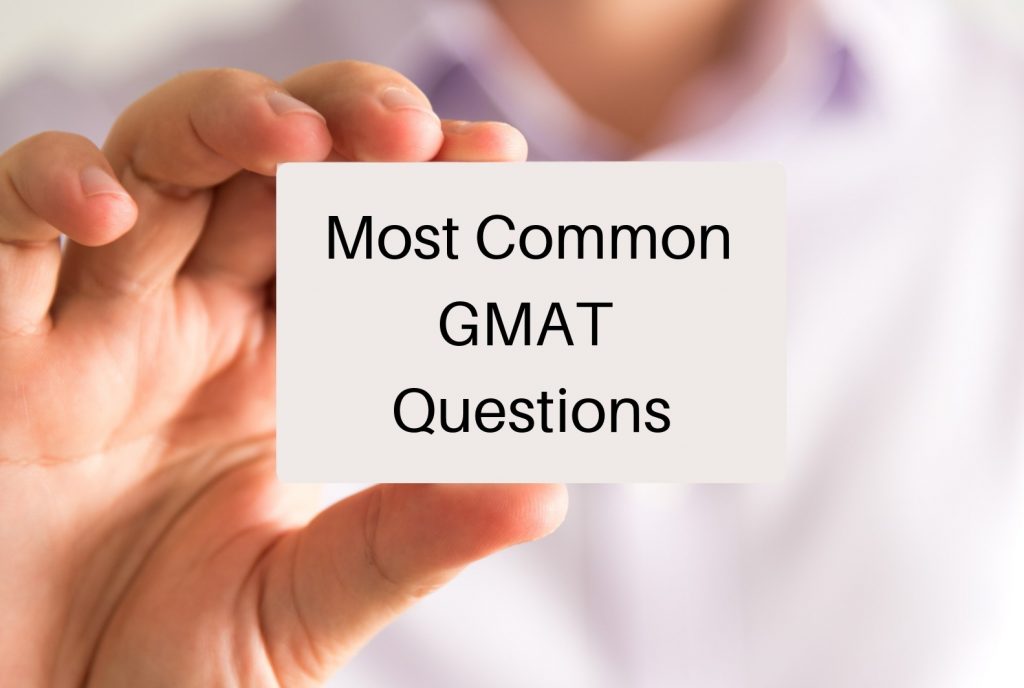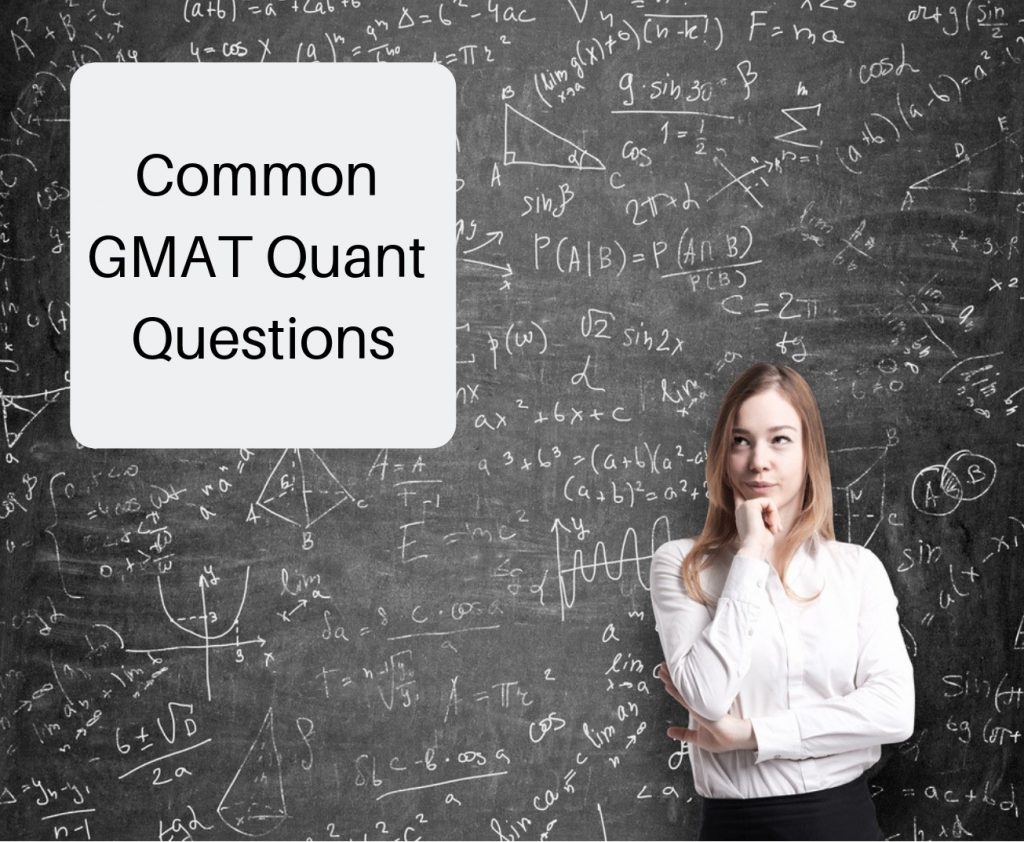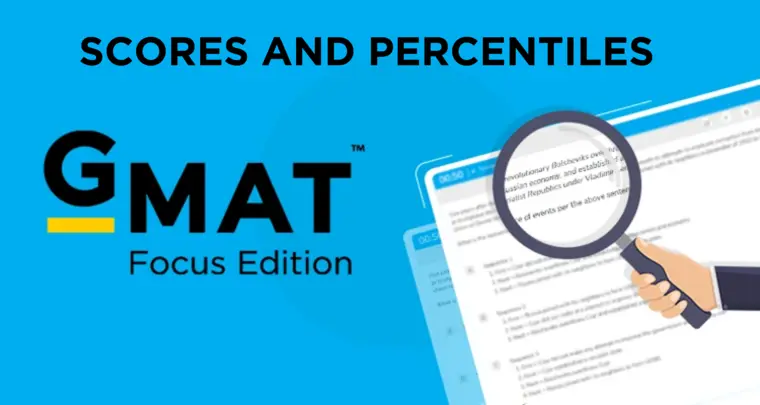GMAT is the standardized test which is considered for admission into graduate management programs around the world. For those of you who have heard about the GMAT in passing or are considering taking the GMAT we are providing some of the most common GMAT practice questions in this article. Make sure you read till the end as we provide the answers to these questions as well.

Most common GMAT questions in Quant: GMAT Practice Questions
The GMAT Quantitative section consists of 2 question types called Problem Solving and Data Sufficiency.
Here’s what the GMAC says about the Quantitative section in the GMAT:
The Quantitative section measures your ability to analyze data and draw conclusions using reasoning skills. The mathematics needed to understand and solve the questions in this section of the GMAT® exam is no greater than what is generally taught in secondary school classes. You will have 62 minutes to complete 31 multiple-choice questions. The Quantitative section has two question types: Problem Solving and Data Sufficiency.
GMAT Practice Questions for Quantitative Section

GMAT Practice Question 1:
Sub-Type: Algebra (Problem Solving) –
If r and s are integers such that |r – s| > 4, which of the following cannot be possible values of (r, s)?
- (-1, -6)
- (-6, -1)
- (1, 6)
- (6, 1)
- (-1, 1)
GMAT Practice Question 2:
Sub-Type: Algebra (Data Sufficiency)
If a and b are positive numbers, is a < b?
- a < b/2 + 2
- a < b/2 -2
Answer Options:
- Statement (1) ALONE is sufficient, but statement (2) alone is not sufficient
- Statement (2) ALONE is sufficient, but statement (1) alone is not sufficient
- Both statements TOGETHER are sufficient, but NEITHER statement ALONE is sufficient
- EACH statement ALONE is sufficient
- Statements (1) and (2) TOGETHER are NOT sufficient
GMAT Practice Question 3:
Sub-Type: Geometry (Problem Solving)
A square photograph is set inside a square frame. If the photograph has a side length of n, and the width of the frame is p, which of the following represents the area of the frame?5
- 2p2 – n2
- 2(p2 – n2)
- 2p (n + p)
- 4p (n + p)
- 4n (p2 – n)
GMAT Practice Question 4:
Sub-Type: Geometry (Data Sufficiency)
Does the line L intersect the graph of the curve y = x2 – 6?
- The slope of line L is 1 and it passes through origin.
- The line L passes through the point (-2, -2) and (2, 2).
Answer Options:
- Statement (1) ALONE is sufficient, but statement (2) alone is not sufficient
- Statement (2) ALONE is sufficient, but statement (1) alone is not sufficient
- Both statements TOGETHER are sufficient, but NEITHER statement ALONE is sufficient
- EACH statement ALONE is sufficient
- Statements (1) and (2) TOGETHER are NOT sufficient
GMAT Practice Question 5:
Sub-Type: Arithmetic (Problem Solving)
N represents the sum of reciprocals of consecutive integers from 301 to 400, inclusive. Choose the correct option?
- 1/4 <N< 1/3
- 1/6 <N< 1/4
- 1/8 <N< 1/6
- 1/10 <N< 1/8
- 1/12 <N< 1/10
GMAT Practice Question 6:
Sub-Type: Arithmetic (Data Sufficiency)
If M and N are integers such that M = N2 – 1, is M divisible by 12?
- N-1 is the square of an even number
- N+1 is a two-digit number and the sum of its digits is a multiple of 3
Answer Options:
- Statement (1) ALONE is sufficient, but statement (2) alone is not sufficient
- Statement (2) ALONE is sufficient, but statement (1) alone is not sufficient
- Both statements TOGETHER are sufficient, but NEITHER statement ALONE is sufficient
- EACH statement ALONE is sufficient
- Statements (1) and (2) TOGETHER are NOT sufficient
Most Common GMAT Questions in Verbal : GMAT Practice Questions
GMAT Verbal consists of 3 Sections:
- Sentence Correction
- Reading Comprehension
- Critical Reasoning
Here is what the GMAC has to day about the GMAT Verbal Section:
The Verbal Reasoning section of the GMAT® exam measures your ability to read and comprehend written material, to reason and evaluate arguments, and to correct written material to express ideas effectively in English. You will have 65 minutes to complete 36 multiple-choice questions. There are three types of questions: Reading Comprehension, Critical Reasoning, and Sentence Correction.
GMAT Practice Questions for GMAT Verbal Section

GMAT Sample Question 7:
Sub-Type: Sentence Correction
Just before its return to Earth from Mars, the “sick” robotic rover missed revealing the existence of significant organic compounds when it was present and indicated that they existed when they were actually absent.
- when it was present and indicated
- when it was present, indicating
- that was present and indicated
- when present, which indicated
- when they were present and indicated
GMAT Sample Question 8:
Sub-type: Reading Comprehension
RC Passage
Jacob Burckhardt’s view that Renaissance European women “stood on a footing of perfect equality” with Renaissance men has been repeatedly cited by feminist scholars as a prelude to their presentation of rich historical evidence of women’s inequality. In striking contrast to Burckhardt, Joan Kelly in her famous 1977 essay, “Did Women Have a Renaissance?” argued that the Renaissance was a period of economic and social decline for women relative both to Renaissance men and to medieval women. Recently, however, a significant trend among feminist scholars has entailed a rejection of both Kelly’s dark vision of the Renaissance and Burckhardt’s rosy one. Many recent works by these scholars stress the ways in which differences among Renaissance women—especially in terms of social status and religion—work to complicate the kinds of generalizations both Burckhardt and Kelly made on the basis of their observations about upper-class Italian women.
The trend is also evident, however, in works focusing on those middle- and upper-class European women whose ability to write gives them disproportionate representation in the historical record. Such women were, simply by virtue of their literacy, members of a tiny minority of the population, so it is risky to take their descriptions of their experiences as typical of “female experience” in any general sense. Tina Krontiris, for example, in her fascinating study of six Renaissance women writers, does tend at times to conflate “women” and “women writers,” assuming that women’s gender, irrespective of other social differences, including literacy, allows us to view women as a homogeneous social group and make that group an object of analysis. Nonetheless, Krontiris makes a significant contribution to the field and is representative of those authors who offer what might be called a cautiously optimistic assessment of Renaissance women’s achievements, although she also stresses the social obstacles Renaissance women faced when they sought to raise their “oppositional voices.” Krontiris is concerned to show women intentionally negotiating some power for themselves (at least in the realm of public discourse) against potentially constraining ideologies, but in her sober and thoughtful concluding remarks, she suggests that such verbal opposition to cultural stereotypes was highly circumscribed; women seldom attacked the basic assumptions in the ideologies that oppressed them.
GMAT Sample Question 8.1:
The author of the passage discusses Krontiris primarily to provide an example of a writer who _______?
A. is highly critical of the writings of certain Renaissance women
B. supports Kelly’s view of women’s status during the Renaissance
C. has misinterpreted the works of certain Renaissance women
D. has rejected the views of both Burckhardt and Kelly
E. has studied Renaissance women in a wide variety of social and religious contexts
GMAT Sample Question 8.2:
According to the passage, Krontiris’s work differs from that of the scholars mentioned in highlighted text in which of the following ways?
A. Krontiris’s work stresses the achievements of Renaissance women rather than the obstacles to their success.
B. Krontiris’s work is based on a reinterpretation of the work of earlier scholars.
C. Krontiris’s views are at odds with those of both Kelly and Burkhardt.
D. Krontiris’s work focuses on the place of women in Renaissance society.
E. Krontiris’s views are based exclusively on the study of a privileged group of women.
GMAT Sample Question 8.3:
According to the passage, feminist scholars cite Burckhardt’s view of Renaissance women primarily for which of the following reasons?
A. Burckhardt’s view forms the basis for most arguments refuting Kelly’s point of view.
B. Burckhardt’s view has been discredited by Kelly.
C. Burckhardt’s view is one that many feminist scholars wish to refute.
D. Burckhardt’s work provides rich historical evidence of inequality between Renaissance women and men.
E. Burckhardt’s work includes historical research supporting the arguments of the feminist scholars.
GMAT Sample Question 8.4:
It can be inferred that both Burckhardt and Kelly have been criticized by the scholars mentioned in highlight text for which of the following?
A. Assuming that women writers of the Renaissance are representative of Renaissance women in general
B. Drawing conclusions that are based on the study of an atypical group of women
C. Failing to describe clearly the relationship between social status and literacy among Renaissance women
D. Failing to acknowledge the role played by Renaissance women in opposing cultural stereotypes
E. Failing to acknowledge the ways in which social status affected the creative activities of Renaissance women
GMAT Sample Question 8.5:
The author of the passage suggests that Krontiris incorrectly assumes that
A. social differences among Renaissance women are less important than the fact that they were women
B. literacy among Renaissance women was more prevalent than most scholars today acknowledge
C. during the Renaissance, women were able to successfully oppose cultural stereotypes relating to gender
D. Renaissance women did not face many difficult social obstacles relating to their gender
E. in order to attain power, Renaissance women attacked basic assumptions in the ideologies that oppressed them
GMAT Sample Question 8.6:
The last sentence in the passage serves primarily to
A. suggest that Krontiris’s work is not representative of recent trends among feminist scholars
B. undermine the argument that literate women of the Renaissance sought to oppose social constraints imposed on them
C. show a way in which Krontiris’s work illustrates a “cautiously optimistic”assessment of Renaissance women’s achievements
D. summarize Krontiris’s view of the effect of literacy on the lives of upper- and middle-class Renaissance women
E. illustrate the way in which Krontiris’s study differs from the studies done by Burckhardt and Kelly
GMAT Sample Question 8.7:
The author of the passage implies that the women studied by Krontiris are unusual in which of the following ways?
A. They faced obstacles less formidable than those faced by other Renaissance women.
B. They have been seen by historians as more interesting than other Renaissance women.
C. They were more concerned about recording history accurately than were other Renaissance women.
D. Their perceptions are more likely to be accessible to historians than are those of most other Renaissance women.
E. Their concerns are likely to be of greater interest to feminist scholars than are the ideas of most other Renaissance women.
GMAT Sample Question 9:
Type: Critical Reasoning
Sub-type: Logical Completion
A recent study shows that teenagers participating in after school creative activities such as music and painting are more likely to show symptoms of depression than teenagers who do not engage in such activities. It was also observed that teenagers who participated exclusively in sports showed the least signs of depression. Although one cannot conclude from these results that depression is caused merely by participating in creative activities, there is definitely a correlation between depression and engagement in such activities as the study also showed that
———————————————————————————————————————
Which of the following statements most logically completes the above passage?
- girls participating in after-school creative activities reported higher rates of depression than boys participating in such activities.
- teenagers participating in activities such as music and painting were found to be significantly more introverted than teenagers participating in sports activities.
- there was no difference between the magnitudes of the depressive symptoms observed in teenagers who participated in both creative and sports activities and those who participated just in creative ones.
- some very famous musicians and painters are patients of a psychological disorder called schizophrenia.
- the use of mood enhancing drugs was more prevalent among the students of schools winning various arts competitions than in the students of schools winning sports competitions.
GMAT Sample Question 10:
Type: Critical Reasoning
Sub-type: Boldface
Many people choose listening to a particular kind of music that is compatible with the mental state they are in. However, studies have shown that people can report feeling happier and calm after listening to sad music. Nevertheless, it is uncalled for to conclude that sad music actually makes people happy. The studies also found that the people only felt positive emotions after listening to sad music when the purpose of listening to it was to release emotions. Contrarily, when the purpose of listening to such music was to recall memories, people felt even more morose after listening to sad music.
In the above argument, the two boldface portions play which of the following roles?
- The first is an observation that the argument accepts as true; the second is a belief that forms part of the support for the main conclusion of the argument.
- The first is evidence against the main conclusion of the argument; the second is an intermediate conclusion used to support the main conclusion of the argument.
- The first is evidence that is used to support a conclusion drawn in the argument; the second is part of the reasoning used to support another conclusion drawn in the argument.
- The first is an observation, an implication of which is disputed in the argument; the second is part of the reasoning used to support the position taken by the argument as a whole.
- The first is a belief that the argument does not dispute; the second is an observation that forms part of the support for the main conclusion of the argument
GMAT Sample Question 11:
Type: Critical Reasoning
Sub-type: Assumption
In Varisland, when a subscriber of one telecom operator calls a subscriber of a different telecom operator, the latter’s telecom company charges a small connection fee to the originating operator, a fee stipulated by the regulator and same for every operator. Almost all the new telecom operators are enticing customers by charging much lower call rates than charged by the existing operators. Since the connection fee is one of the sources of revenue for new companies, an increase in the fee will significantly improve the financials of the new operators and enable them to compete better in the market.
Which of the following statements is an assumption made by the author?
- The regulator will most probably agree with the author’s recommended course of action
- To improve the financials of the new companies, all the possible sources of revenues should be utilized in the best manner possible.
- One of the goals of the regulator is to make the telecom market highly competitive, which will ensure consumer welfare.
- For the new telecom operators, the connection fee does not form an insignificant proportion of their revenues
- New companies will not have to pay increased connection fee to the existing companies
GMAT Sample Question 12:
Type: Critical Reasoning
Sub-type: Strengthen
A restaurant that comes up with an innovative dish can normally increase its profits by capitalizing on the novelty of the dish. Since recipes can be easily replicated, the restaurant with a new dish advertises it aggressively to attract customers while the novelty factor can still be used as a selling point. But aggressive advertising generates a fear of losing customers in the competitors and gives them a strong incentive to quickly replicate the new dish. Therefore, the strategy to maximize overall profit from a new dish is to advertise it selectively.
Which of the following, if true, strengthens the suggestion given by the author?
- The patrons of a restaurant are the ones who are most likely to try a new dish at the restaurant.
- The word of mouth publicity generated by the customers of the restaurant is a good enough reason for the competitors to replicate the dish.
- The recipes for the innovative dishes are usually kept under close guard by the restaurants that develop the dishes.
- Aggressive marketing usually generates far more profits than does selective marketing.
- Selective marketing has been proven to be an effective strategy for fast food restaurant chains.
GMAT Sample Question 13:
Type: Critical Reasoning
Sub-type: Weaken
Mathematics Professor at Hartworth College: The performance of the current batch of Hartworth College students in the Mathematics course has been the best till date. Our current batch of students studying Mathematics has broken the record for the last highest average grade received by any batch in the course. This year, the average grade of the students enrolled in the Mathematics course saw a 7 percent increase over the previous highest average grade for the course that was recorded in the year 2009.
Which of the following most weakens the Professor’s statement?
- The grading system at Hartworth for a particular course differs from the grading system followed by other colleges.
- The performance of the current batch in Economics, a subject that utilizes Mathematical knowledge for a few concepts, has been the worst in the history of Hartworth.
- The grading methodology followed for any course evaluation has never been changed since the college was first founded in 1975.
- Each course in Hartworth follows a grading system in which the grades reflect scores that are computed as a percentage of the course topper’s absolute marks.
- In the current batch, the number of students who scored above 90 percent in the course is less than the number of students who scored above 90 percent in 2009.
Answer Key:
below is the Answer key for all the above GMAT Practice Questions:
Question # |
Correct Answer |
Question # |
Correct Answer |
1 |
5 |
8.4 |
B |
2 |
2 |
8.5 |
A |
3 |
4 |
8.6 |
C |
4 |
4 |
8.7 |
D |
5 |
1 |
9 |
3 |
6 |
1 |
10 |
4 |
7 |
5 |
11 |
4 |
8.1 |
D |
12 |
1 |
8.2 |
E |
13 |
4 |
8.3 |
C |
|
|
If you faltered in a particular type of question above or have conceptual doubts about a particular question type, below is a list of free resources that will be helpful for your GMAT preparation:
- GMAT Critical Reasoning Free Webinar (Learn the Pre-Thinking based approach to nail 700 level GMAT CR Questions)
- GMAT Reading Comprehension Free Webinar (Ace GMAT RC in 10 days with strategies taught in this session)
- GMAT Arithmetic Free Webinar
- GMAT Strategy Session (Strategy to score 760+ in the GMAT)
- e-GMAT Free Trial (Get access to 10+ hours of video lessons and 400+ practice questions)
Disclaimer 1: The GMAT practice questions featured in this article are the intellectual property of e-GMAT. They may not be reproduced elsewhere without permission.
Disclaimer 2: The RC Passage and Questions are taken from the GMAT OG. All rights belong to their respective publishers.
If you are planning to take the GMAT, we can help you with a personalized study plan and give you access to quality online content to prepare. Write to us at acethegmat@e-gmat.com. We are the most reviewed GMAT prep company on GMAT club with more than 2600 reviews and are the only prep company that has delivered more than 700+ scores than any other GMAT club partner. Why don’t you take a free trial and judge for yourself?














